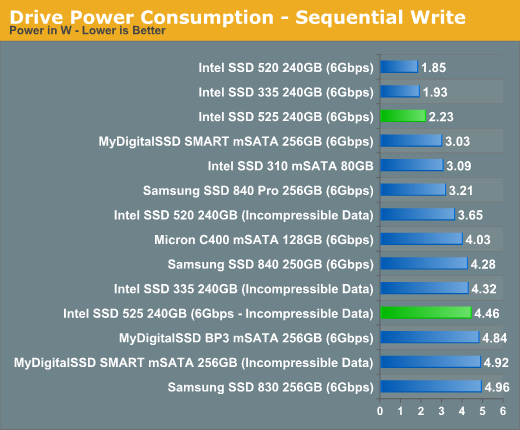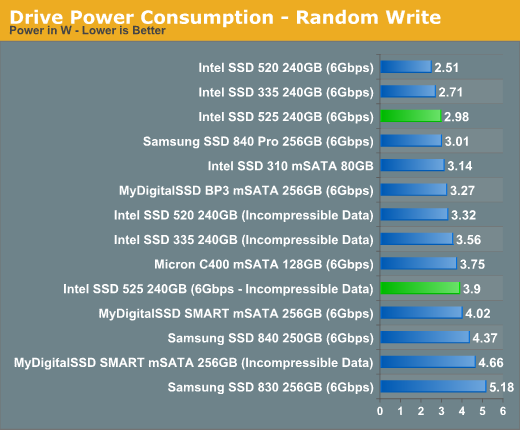Intel SSD 525 Review (240GB)
by Anand Lal Shimpi on January 30, 2013 1:42 AM ESTTRIM Functionality
SandForce has always exhibited strange behavior when it came to TRIM. Even Intel's custom firmware in the SSD 520 wasn't able to fix SandForce's TRIM problem. The issue happens when the SSD is completely filled with incompressible data (both user LBAs and spare area). Any performance degradation after that point won't be restored with a TRIM pass and instead will require a secure erase to return to new. None of the Intel SF SSDs have been able to fix this issue and the 525 is no exception. I ran a slightly modified version of our usual test here. I filled the drive with incompressible data, ran our consistency workload (also with incompressible data) then measured performance using a 128KB (incompressible) pass in IOmeter. I then TRIMed the entire drive and re-ran the IOmeter test.
| Intel SSD 525 Resiliency - IOMeter 128KB Incompressible Sequential Write | |||||
| Clean | After Torture (30 mins) | After TRIM | |||
| Intel SSD 525 240GB | 293.5 MB/s | 59.8 MB/s | 153.3 MB/s | ||
And the issues persists. This is really a big problem with SandForce drives if you're going to store lots of incompressible data (such as MP3s, H.264 videos and other highly compressed formats) because sequential speeds may suffer even more in the long run. As an OS drive the SSD 335 will do just fine since it won't be full of incompressible data, but I would recommend buying something non-SandForce if the main use will be storage of incompressible data.
Power Consumption
Idle power consumption is appreciably lower on the 525 than on the 520, however it's still not as low as the latest from Samsung. According to SandForce, a newer silicon spin of the SF-2281 controller exists that drives idle power consumption down even lower however most drive makers haven't chosen to implement it. Intel confirmed that it's still using the same silicon as the 525, so all improvements here are purely due to firmware.
Despite the gains in idle power consumption, I did measure consistently higher power consumption under active workloads. The gains at idle are more important to improving battery life, although I would liked to have seen reductions across the board. Even more, if SandForce has newer, lower power silicon available I'd like to see that used as well. SandForce tells me that its new low power SF-2281 revision is mostly used by OEMs at this point, not channel drive vendors.
Update: We've measured 525 power consumption using the 3.3V rail supplied directly to the drive.













21 Comments
View All Comments
philipma1957 - Wednesday, January 30, 2013 - link
meaker10 have you used a msi gt60?critical_ - Wednesday, January 30, 2013 - link
I'm using Startech's SAT2MSAT25. It is a "passthrough" design so it'll work at 6Gbps is your controller supports it.HyperJuni - Wednesday, January 30, 2013 - link
I was hoping for a comparison with the m4/C400 mSATA 256GB, since it seems to differ a bit in performance from the 128GB model, and would be better suited as a "direct competitor" to the 240GB 525 for the same of comparison IMHO.Too bad you didn't include it in the charts, Anand.
nathanddrews - Wednesday, January 30, 2013 - link
Since IOPS consistency improves significantly when setting aside 25% spare area, what is the practical effect in real world? Has this been documented using the AT Storage Bench? Under default conditions, the 840 Pro dominates the top of the charts, but does it still retain the crown after being "stroked"? Just curious...SanX - Wednesday, January 30, 2013 - link
Is it burning hot for its size? Will it fry your eggs?SanX - Wednesday, January 30, 2013 - link
damn cellphone spell-correction typo and lack of edit option like on cheap websites: ***incompressible***dealcorn - Wednesday, January 30, 2013 - link
The prospect of the S3700 technology in a consumer drive has appeal except that the S3700 uses too much power. Is Intel's approach inherently inefficient or is it reasonable that Intel can tune the technology differently for the consumer market to achieve competitive efficiency?name99 - Wednesday, January 30, 2013 - link
"Why does Intel continue to use a third party SATA controller in many of its flagship drives? Although I once believed this was an issue with Intel having issues on the design front, I now believe that a big part of it has to do with the Intel SSD group being more resource constrained than other groups within the company.
"
This seems strangely short sighted. How is flash controlled on mobile devices?
Obviously performance is substantially lower. It's not clear to me how that lowering is split between
- cheaper, lower-end flash
- only one rank (or whatever flash their call their equivalent), ie limited parallelism
- a dumb controller.
However there doesn't seem to be any aspect of the problem that is inherently power limited.
Which implies that if Intel wanted a way to make their perpetually lagging Atom SOCs a little more noteworthy, one way to do so would be to work on them having flash support that was substantially faster than what's available on ARM today.
emvonline - Thursday, January 31, 2013 - link
Sandforce controllers are high performance, have no DRAM need, and allow both SF standard and custom firmware. Until SF drops the ball on performance or support I would look for more SSDs to be based on the SF design, not less. Enterprise is different ball game where ASPs/margins are much higher so custom controller might make sense (volumes are much lower though). If other 3rd party controllers mature, I expect them to gain market share as well.damnintel - Wednesday, March 13, 2013 - link
heyyyy check this out damnintel dot com